Nothing brings back Christmas memories quite like the sight and aroma of freshly steamed Puto Bumbong outside our local church after Simbang Gabi.
I can still vividly remember rushing with my siblings to join the queue of parishioners, all of us eager to get our hands on these warm purple rice cakes alongside piping hot bibingka.
I've perfected this recipe after countless attempts to recreate that taste from my childhood. The secret lies in using the right combination of purple rice varieties and following the traditional two-day soaking process, shortcuts just won't give you that authentic texture and natural purple hue we all remember.
Let me guide you through making this beloved Filipino Christmas delicacy at home, down to those essential toppings of melty butter, freshly grated coconut, and muscovado sugar that make Puto Bumbong truly special.
While the process takes patience, I promise the end result will transport you right back to those cherished dawn masses with that first heavenly bite making all the effort worthwhile.
What is Puto Bumbong?
Puto Bumbong is a traditional Filipino purple rice cake, meticulously crafted by steaming ground purple rice inside bamboo tubes called "bumbong ng kawayan." A cherished Christmas delicacy served during Simbang Gabi (Dawn Mass), it features a natural violet hue from special rice varieties, crowned with melted butter, freshly grated coconut, and muscovado sugar.
Jump to:
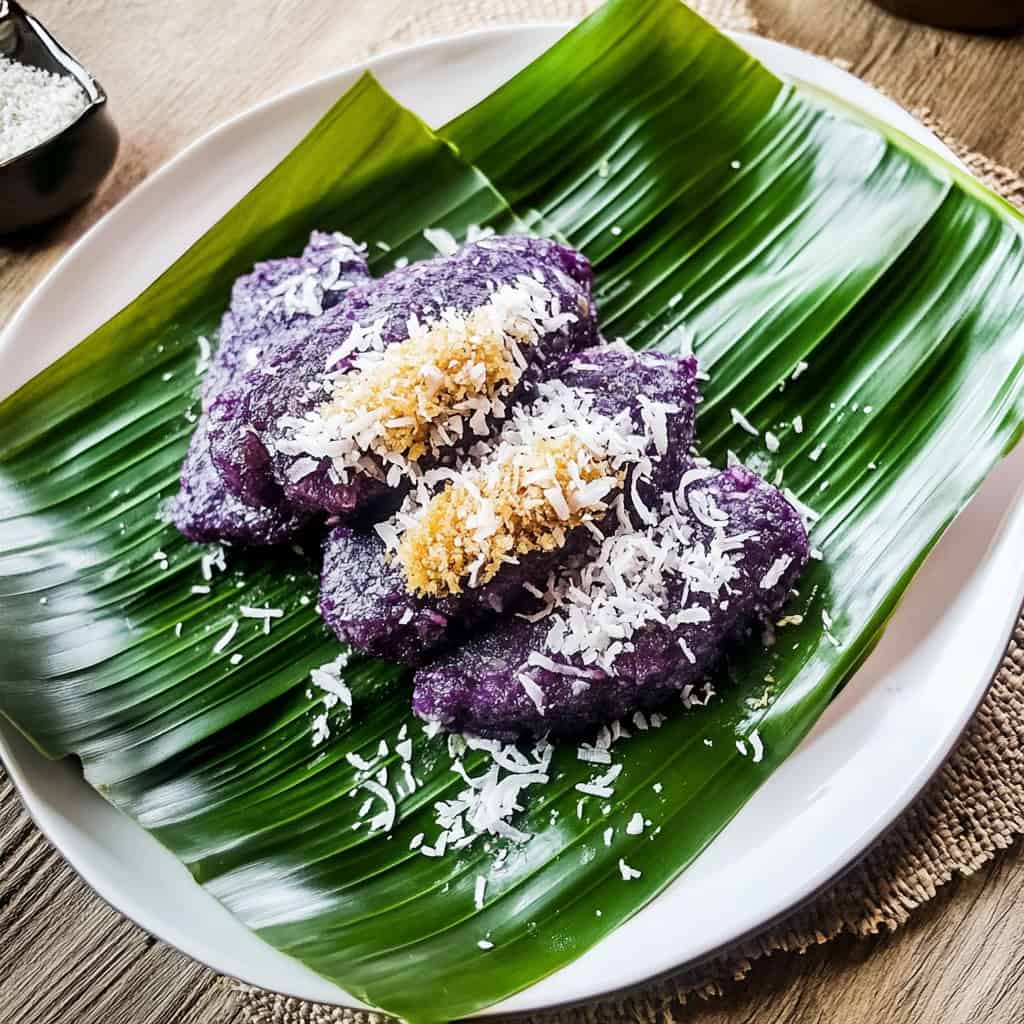
Why You'll Love This Recipe
- Authentic purple hue from natural rice (no artificial coloring)
- Perfect blend of three rice varieties for ideal texture
- Traditional Christmas season delicacy (Parol Season special)
- Completely customizable toppings
- Step-by-step instructions with Tagalog translations
- Family recipe perfected through generations
Ingredients
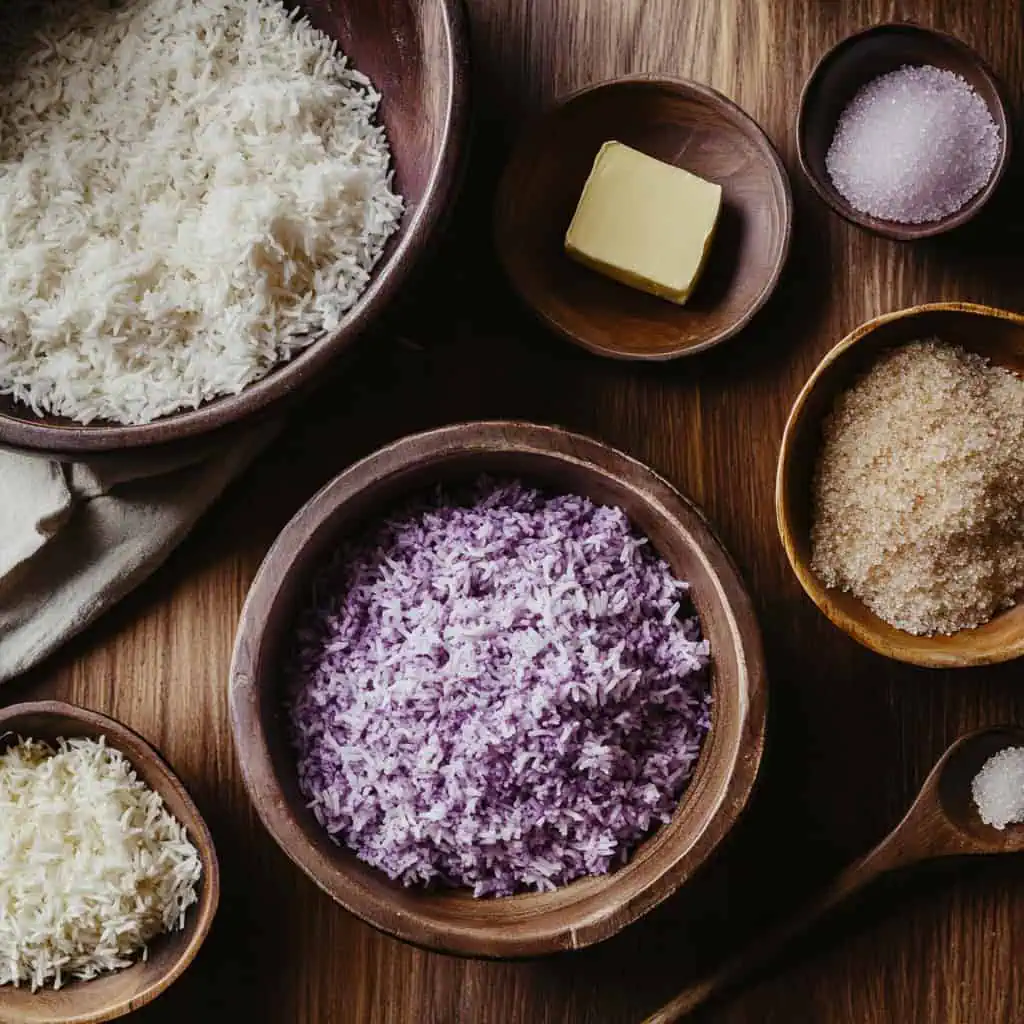
For the Rice Cake:
- 1⅓ cups sticky purple rice
- 1⅓ cups white glutinous rice
- ⅔ cup long grain purple rice
- 6 cups water for soaking
For Toppings:
- ¾ cup muscovado sugar
- 1½ cups freshly grated coconut
- ½ cup softened butter or margarine
Equipment
- Puto Bumbong Steamer - Traditional steamer with special slots for bamboo tubes; this specialized equipment allows steam to pass through the bamboo tubes for even cooking
- Bamboo Tubes - 3-4 tubes, each about 6 inches long; these give the puto bumbong its characteristic shape and impart a subtle bamboo flavor
- Food Processor - For grinding the soaked rice to a fine, sand-like consistency
- Large Glass or Ceramic Bowl - For soaking the rice; avoid metal bowls as they can affect the flavor and fermentation process
- Fine-Mesh Sieve - For draining the soaked rice thoroughly
- Banana Leaves - For serving and providing an authentic aroma to the dish
- Pastry Brush - For applying butter evenly to the freshly steamed puto bumbong
- Wooden Spoon - For handling and shaping the rice mixture
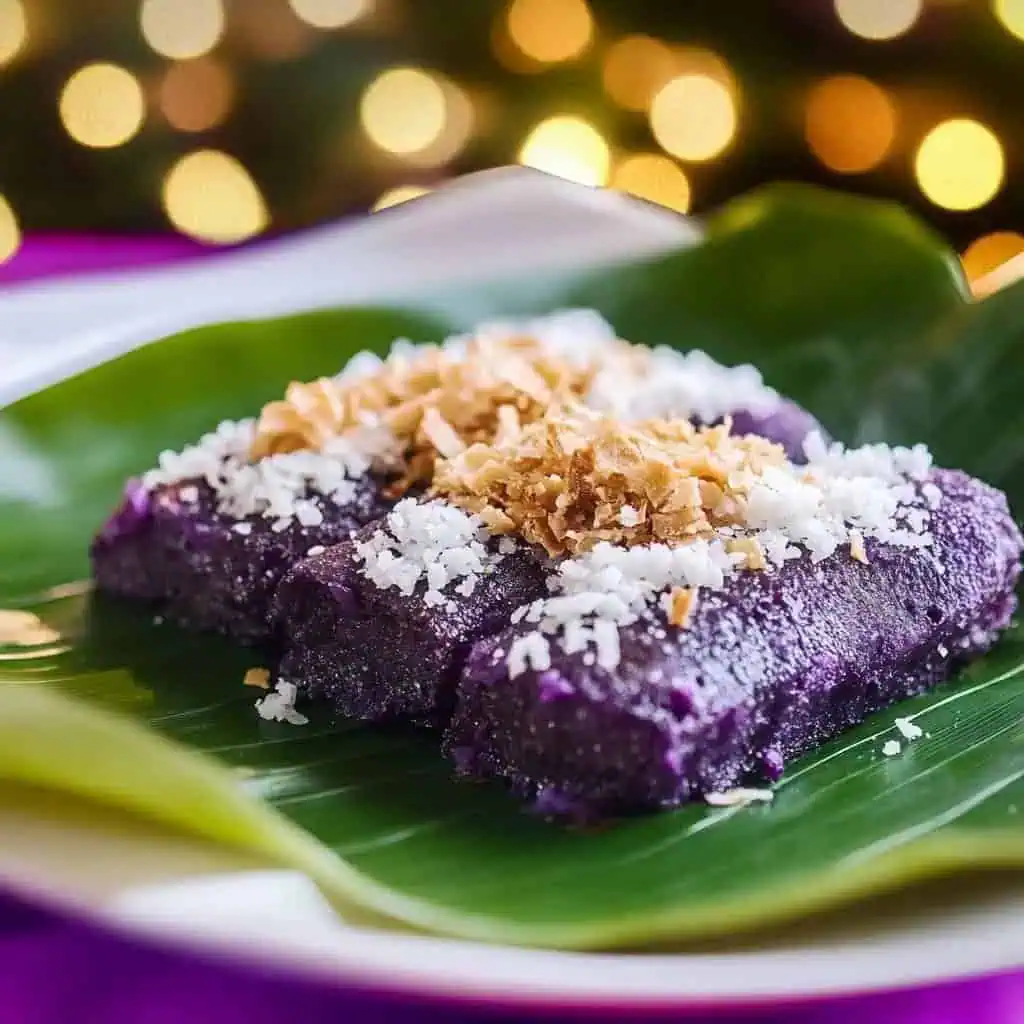
How To Make
Day 1 - Rice Preparation:
- In a large glass or ceramic bowl (never metal), combine 1⅓ cups sticky purple rice, 1⅓ cups white glutinous rice, and ⅔ cup long grain purple rice.
- Add 6 cups of clean water and soak at room temperature (27-30°C).
- Cover the bowl and let stand for 24 hours.
Day 2 - Water Change:
- After 24 hours, drain the rice and replace with fresh water.
- Continue soaking for another 24 hours at room temperature.
Day 3 - Final Preparation and Cooking:
- Drain the soaked rice thoroughly using a fine-mesh sieve.
- Process in a food processor for about 10 minutes until very fine, like sand texture.
- Prepare your puto bumbong steamer by filling it halfway with water and bringing it to a rolling boil (100°C).
- Loosely fill the bamboo tubes with the rice mixture - don't pack too tightly.
- Place the filled tubes in the steamer slots and steam for 3-5 minutes. You'll know it's done when steam visibly escapes from the top of the tube.
Serving:
- Immediately slide the cooked puto bumbong onto banana leaves.
- While still very hot, spread softened butter over the top, followed by a generous amount of freshly grated coconut, and finish with a sprinkle of muscovado sugar.
- Serve immediately while piping hot, traditionally paired with hot chocolate.

Tips from Lola's Kitchen
- Soaking container matters - Always use ceramic or glass containers for soaking rice, never metal, which can react with the fermentation process
- Water change is essential - Change the soaking water after exactly 24 hours for cleaner flavor and better fermentation
- Test for doneness properly - Look for steam rising consistently from the top of the bamboo tube as the primary indicator of readiness
- Keep coconut fresh - Store freshly grated coconut in the refrigerator until right before serving to maintain its sweet flavor
- Temperature is key - Serve puto bumbong immediately while still hot for the best texture and flavor experience
- Bamboo preparation - Soak bamboo tubes in water for 30 minutes before first use to prevent burning and cracking
- Steamer water level - Maintain proper water level in the steamer to ensure consistent steam throughout the cooking process
Substitutions
- Purple Rice Alternative: If you can't find sticky purple rice, use a mixture of black rice and regular glutinous rice in a 1:1 ratio
- Muscovado Sugar Substitute: Brown sugar mixed with a teaspoon of molasses can replicate the deep flavor of muscovado
- Fresh Coconut Alternative: Frozen grated coconut (thawed and warmed) works in a pinch, though fresh is always preferred
- Butter Options: Margarine or coconut oil can be used instead of butter for different flavor profiles
- Bamboo Tube Alternatives: If authentic bamboo tubes aren't available, aluminum foil formed into tubes can work as a modern substitute, though the flavor will be slightly different
- Steamer Alternative: A regular steamer with a clean cloth can work if you don't have a specialized puto bumbong steamer
Troubleshooting
- Rice mixture too wet:
- Add small amounts of dry rice flour to absorb excess moisture
- Drain the soaked rice longer before grinding
- Process for an additional 2-3 minutes to achieve drier consistency
- Not cooking through:
- Ensure your steamer is producing strong, consistent steam
- Don't pack the bamboo tubes too tightly with the rice mixture
- Check that water level in steamer is sufficient and maintained throughout cooking
- Consider extending cooking time by 1-2 minutes if needed
- Color not purple enough:
- Increase the ratio of purple rice in your mixture
- Ensure the quality of your purple rice is good and fresh
- Avoid washing the rice too vigorously before the soaking process
- Source your purple rice from specialty Asian grocers for authentic varieties
- Puto sticking to bamboo:
- Lightly oil the inside of bamboo tubes before filling
- Ensure bamboo tubes are properly soaked before first use
- Use a small wooden skewer to gently separate the edges before removing
Storage & Reheating
- Optimal consumption: Puto bumbong is best enjoyed immediately after cooking
- Short-term storage: Can be stored in an airtight container at room temperature for up to 24 hours
- Refrigeration: If needed, refrigerate for up to 2 days, but texture will change significantly
- Freezing: Not recommended as the texture becomes compromised
To reheat:
- Steaming: Place in steamer for 1-2 minutes until heated through
- Microwave: Wrap in a damp paper towel and microwave for 15-20 seconds
- Important note: Always add fresh toppings after reheating, not before
- Quality expectation: Expect some texture loss after reheating; freshly made is always superior
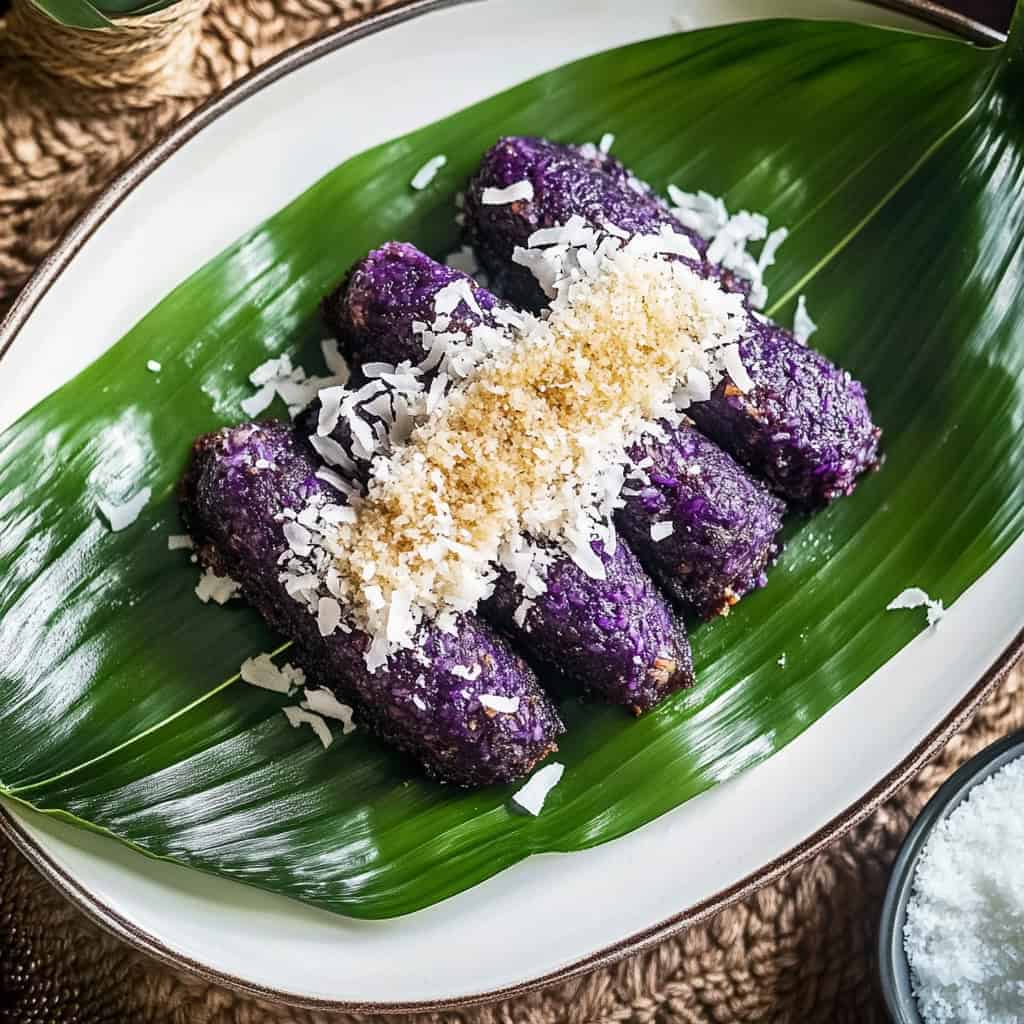
FAQ
Can I use regular purple food coloring instead of purple rice?
While you technically could, authentic puto bumbong derives its color naturally from the rice varieties used. Food coloring won't provide the same flavor or texture that makes this dish special.
Why is it necessary to soak the rice for two full days?
The extended soaking period softens the rice perfectly, develops the right texture, and allows for subtle fermentation that creates the distinctive flavor profile of traditional puto bumbong.
What if I don't have bamboo tubes available?
You can form aluminum foil into tube shapes as an alternative, though the bamboo imparts a distinctive flavor that's part of the authentic experience.
Can I make the rice mixture ahead of time?
You can prepare the soaked and ground rice mixture up to 12 hours ahead, but keep it refrigerated and bring to room temperature before cooking.
Why does authentic puto bumbong have a slightly fermented taste?
The two-day soaking process allows for natural fermentation, which adds complexity to the flavor profile. This is characteristic of traditional preparation.
How do I know when the puto bumbong is perfectly cooked?
When steam consistently rises from the top of the bamboo tube and the rice mixture feels firm yet springy when gently pressed.
What's the best way to serve puto bumbong for a large gathering?
Prepare all ingredients and equipment ahead, then cook in batches throughout your event for the freshest experience. Consider setting up a toppings station.
Related
Looking for other recipes like this? Try these:
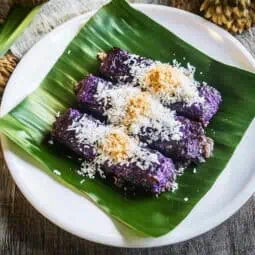
Traditional Filipino Puto Bumbong (Purple Rice Cake)
Equipment
- Puto Bumbong Steamer (Pangsteam ng Puto Bumbong) Traditional steamer with special slots for bamboo tubes
- Bamboo Tubes (Bumbong ng Kawayan) Used for authentic steaming and shape, 3-4 tubes, each about 6 inches long
- Food Processor (Panggiling) For grinding rice to fine consistency
- Large mixing bowl (Malaking mangkok)
- Fine-Mesh Sieve
- Banana Leaves (Dahon ng Saging) For serving and authentic aroma
Ingredients
For the Rice Cake:
- 1⅓ cups sticky purple rice malagkit na purple rice
- 1⅓ cups white glutinous rice malagkit na bigas
- ⅔ cup long grain purple rice mahabang butil na purple rice
- 6 cups water for soaking
For Toppings:
- ¾ cup muscovado sugar asukal na muscovado
- 1½ cups freshly grated coconut bagong kudkod na niyog
- ½ cup softened butter or margarine pinalambot na mantikilya
Instructions
Day 1 - Rice Preparation (Paghahanda ng Bigas):
- In a large glass or ceramic bowl (never metal), combine 1⅓ cups sticky purple rice, 1⅓ cups white glutinous rice, and ⅔ cup long grain purple rice. Add 6 cups of clean water and soak at room temperature (27-30°C). Cover the bowl and let stand for 24 hours.
Day 2 - Water Change (Pagpapalit ng Tubig):
- After 24 hours, drain the rice and replace with fresh water. Continue soaking for another 24 hours at room temperature.
Day 3 - Final Preparation and Cooking (Pagluluto):
- Drain the soaked rice thoroughly using a fine-mesh sieve. Process in a food processor for about 10 minutes until very fine, like sand texture (parang buhanging pino). Prepare your puto bumbong steamer (pangsteam ng puto bumbong) by filling it halfway with water and bringing it to a rolling boil (100°C).
- Loosely fill the bamboo tubes with the rice mixture - don't pack too tightly. Place the filled tubes in the steamer slots and steam for 3-5 minutes. You'll know it's done when steam visibly escapes from the top of the tube (tapos na kapag may usok na lumalabas sa taas ng tube).
Serving (Paghahain):
- Immediately slide the cooked puto bumbong onto banana leaves (dahon ng saging). While still very hot, spread softened butter (mantikilya) over the top, followed by a generous amount of freshly grated coconut (bagong kudkod na niyog), and finish with a sprinkle of muscovado sugar (asukal na muscovado).
- Serve immediately while piping hot (ihain habang mainit pa), traditionally paired with hot chocolate (tsokolate).
Tips from Lola's Kitchen
- Soak rice in ceramic or glass container, never metal
- Change soaking water after 24 hours for cleaner taste
- Test doneness by checking if steam rises from tube top
- Keep grated coconut chilled until serving
- Serve immediately while piping hot
Nutrition
The Story Behind Filipino Puto Bumbong
The story of Puto Bumbong weaves deeply into the fabric of Filipino Christmas traditions, emerging as a cherished staple of Simbang Gabi, our treasured nine-day dawn mass ritual. This distinctive purple rice cake, whose name literally translates to "bamboo tube rice cake," tells the tale of Filipino ingenuity in transforming simple ingredients into something extraordinary. The "bumbong" in its name refers to the bamboo tubes essential to its preparation, while "puto" identifies it as part of our vast family of traditional rice cakes.
What makes this delicacy particularly special is its historical connection to the Spanish colonial period in the Philippines. As Filipinos attended Misa de Gallo (Rooster's Mass) in the early morning hours, vendors would set up their steaming stations outside church doors, preparing these purple treats for worshippers. The timing was perfect – the hot, freshly steamed rice cakes provided warmth and sustenance to those attending mass in the cool December dawn.
The purple hue of traditional Puto Bumbong comes from a special heirloom variety of glutinous rice called pirurutong or tapol, showcasing our ancestors' expertise in selecting and preparing indigenous ingredients. Unlike modern versions that might rely on artificial coloring or ube (purple yam), authentic Puto Bumbong gets its color purely from this special rice variety. The tradition of serving it with butter, freshly grated coconut, and muscovado sugar represents a beautiful blend of native and colonial influences – the rice and coconut being indigenous elements, while the butter and sugar came with Spanish trade.
Today, finding authentic Puto Bumbong made with pure pirurutong rice becomes increasingly rare, as many vendors opt for easier-to-source ingredients. However, this recipe stays true to the traditional preparation methods, ensuring that each bite connects you to generations of Filipino Christmas celebrations. Making Puto Bumbong at home might take more time and effort than buying it from street vendors, but the process of soaking the rice, grinding it to the perfect consistency, and steaming it in bamboo tubes becomes a meaningful way to preserve and pass on this vital piece of our culinary heritage.


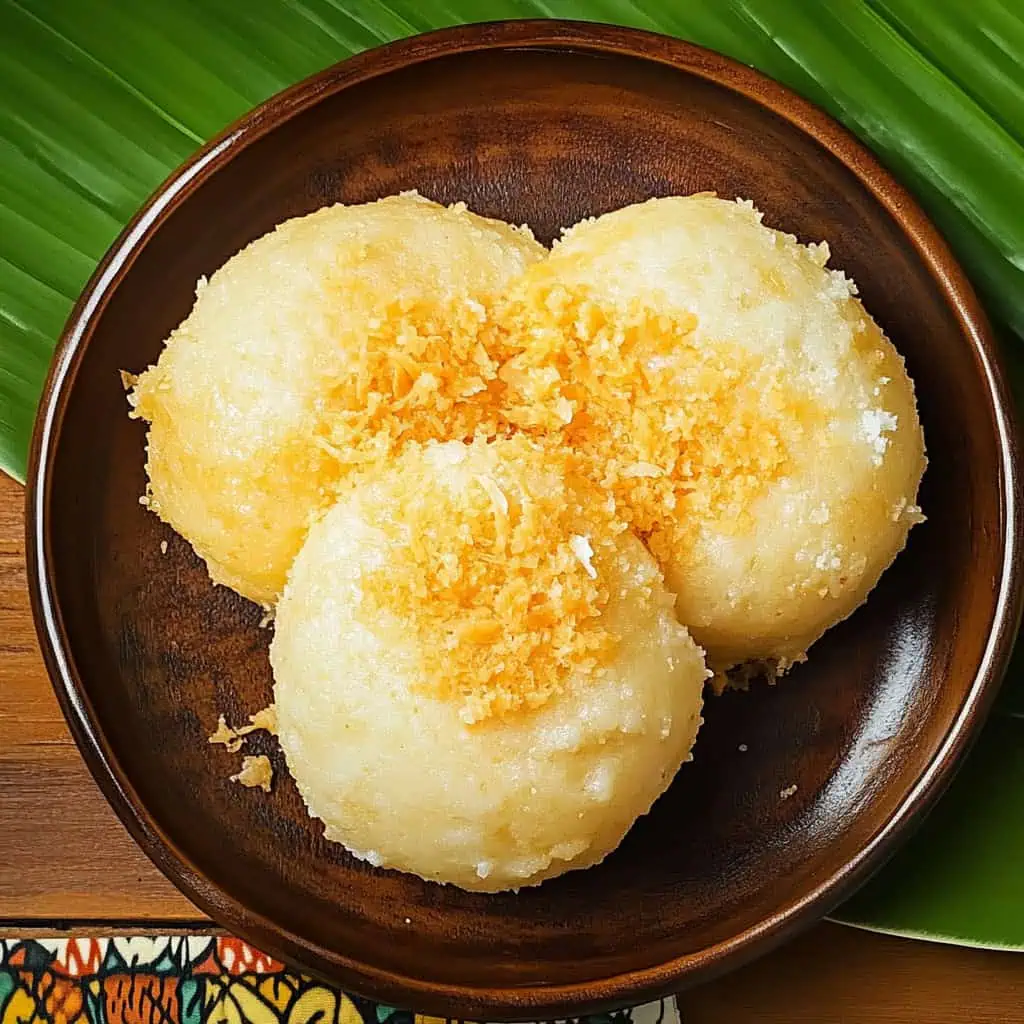
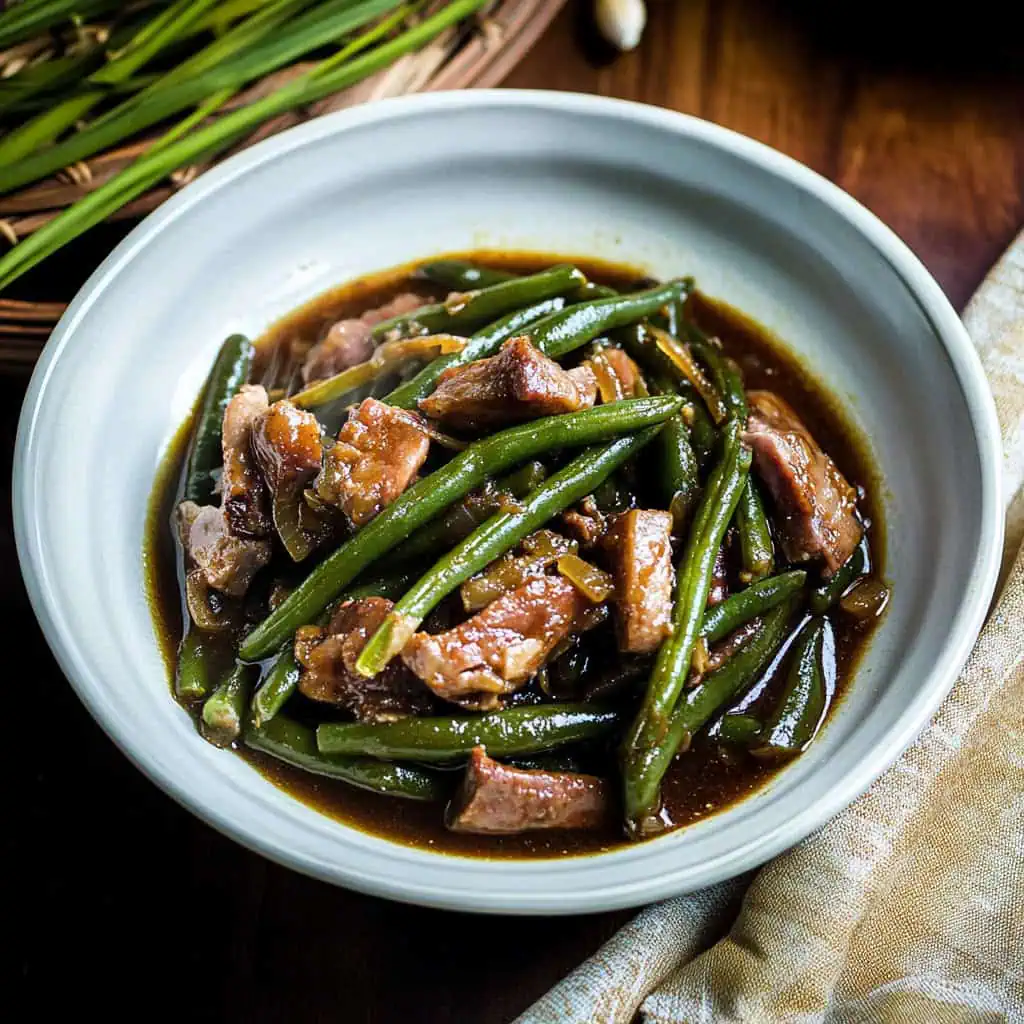






Comments
No Comments